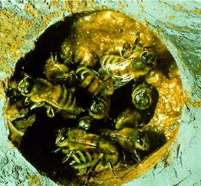|
 |
 |
 HOME > Product Information > Feed additives HOME > Product Information > Feed additives |
|
|
 |
 |
 |
Propolis is a mixture of some secretions from bees and resins from plants. To protect the hive and its nutritious contents from attack by micro-organisms, propolis has anti-microbial properties. Propolis is composed of chemicals (especially flavonoids), which play a role as antiviral and antibacterial agents.
Laboratory tests have demonstrated that propolis is effective against over 20 kinds of bacteria. Clinical studies also demonstrated that propolis was effective against various kinds of bacterial, fungal, and viral infections. According to recent study, active ingredients in propolis significantly inhibited flu virus also.
|
| As it is getting more strict in using antibiotics globally, people are highly concerned about organic food and meat. Samjo Life Science goal is to produce a variety of feed additives contain propolis (phytonutrient) and to supply those for our customers.
According to recently report Phytotherapy Research in 2010, a substance in propolis was active against MRSA, which causes potentially fatal infection. They tested extracts of propolis on 15 MRSA strains and isolated two compounds, Propolin C and Propolin D, which showed good activity against all the MRSA strains tested. These could possibly act as templates for the development of improved anti-MRSA agents.
|
|
|
|
|
 |
 Natural antibiotics Natural antibiotics
 Natural antioxidants Natural antioxidants
 Anticancer Anticancer
 Antivirus Antivirus
 Antibacteria Antibacteria
|
|
|
|
|
 |
|
| Substance |
Properties |
Reference |
caffeic acid
(3,4-dihydroxycinnamic acid) |
Antibacterial effect
Antiviral Effect
Cure for imflammation
|
Villanuevaet et al., 1970
Bankova et al., 1983 |
Rutin
(flavoneglycoside) |
Antiviral Effect
Cure for ulcers
|
Konig and Dustmann, 1985
The hive and the honey
bee, 1992 |
P-coumaric acid
(4-hydroxycinnamic acid) |
Antibacterial effect |
Metzner et al., 1979 |
|
|
|
|
|
 |
|
| Bacillus |
penicillin |
tetracycline |
Monmycin |
Propolis |
 |
+ |
++ |
- |
+++ |
 |
+ |
+ |
+ |
+++ |
 |
+ |
++ |
- |
++ |
 |
+ |
+ |
+ |
+++ |
|
|
|
|
 |
 Test period : January 25, 2006 ~ February 25, (30 days) Test period : January 25, 2006 ~ February 25, (30 days)
 Test farm : W farm in Changnyung, Kyungnam Test farm : W farm in Changnyung, Kyungnam
 Test dose : Propolis added to feed for lactation piglets 300g per 1 ton feed Test dose : Propolis added to feed for lactation piglets 300g per 1 ton feed
|
 Result : Result : |
|
|
Weaned pig |
Weaned pig Wt.(kg) |
No. of Weak pig |
No. of survived pigs from weak pigs |
Mortality rate(%) |
| Control group |
340 |
6.8 |
20 |
15 |
25 |
| Test group |
374 |
7.5 |
20 |
19 |
5 |
 Conclusion : Conclusion : |
|
After adding the Propolis to the feed of lactating pigs, the vitality of the 10day-pilglets’ in the test group was better than those of the control group and the recovery rate appeared higher. |
|
The test group’s mortality rate (5%) was considerably lower than the control group’s mortality rate(25%). |
|
|
|
|
 |
 Test period : January 25, 2006 ~ February 25, (30 days) Test period : January 25, 2006 ~ February 25, (30 days)
 Test farm : B farm in Pocheon, Kyungki-do Test farm : B farm in Pocheon, Kyungki-do
 Control group : General antibiotics, probiotics Control group : General antibiotics, probiotics
 Test group : Add propolis product Test group : Add propolis product
|
 Result 1 : Result 1 : |
|
|
Weaned pig |
Survived pig |
Mortality rate |
| Control group |
320 |
308 |
3.75% |
| Test group |
320 |
315 |
1.56% |
 Result 2 : Result 2 : |
|
|
Weaned pig |
Weaned pig Wt.(kg) |
Final Wt.(kg) |
Gained Wt.(kg) |
| Control group |
21 |
6.4 |
17.0 |
10.6 |
| Test group |
19 |
6.2 |
17.6 |
11.4 |
 Conclusion : Conclusion : |
1. In the test group, mortality rate appeared only 1.56% compared to the control group (3.75%).
2. Gained weight in the test group is 7.55% higher more than the control group.
|
|
|
|
|
|
|
|
|
|